Jean Baptiste Camille Corot Biography
Jean-Baptiste-Camille Corot was born on 16 July 1796 in Paris. His family was middle-class. Corot studied at boarding schools in Poissy and Rouen. He was an apprentice draper in Paris. Corot did not take to drapery and persuaded his father to subsidize his art studies in Paris.
Corot started studying at the Ecole des Beaux-Arts, Paris in 1822. His instructors included artists who emphasized landscapes, most notably the printmaker and engraver Louis-François Bertin (1766-1841), and painter Michel Martin Michallon (1786-1851). Corot’s landscapes, however, were more influenced by Romantic landscape painters, in particular Claude Lorrain (1600-1682). Claude’s paintings are idealized landscapes but based on actual locations in France and Italy.
Corot’s travels to Italy strongly affected his art. Corot’s first trip to Italy was in 1825. Courlandais J.K. Baehr, an artist, went with him. Corot and Baehr were part of a group of foreign artists, followers of the XVIIth century masters, Poussin and Claude. (Corot’s first exhibit at the Paris Salon was in 1827.) In Rome, Corot studied the work of Guercino and Guido Reni. Corot traveled extensively in southern Italy. He made numerous oil sketches of the scenery, later developed into finished paintings in his studio. Corot stayed in Italy until 1828 during this first trip.
Corot’s second trip to Italy was in 1834. During this second visit, he focused his attention on Venice, making many oil sketches of its canals and buildings.
Corot’s third, and final, trip to Italy took place when he was nearly fifty years old. He traveled with Pierre Brizard (1737-1804) a painter. They stayed from 1843 to 1844. During this trip, Corot traveled in the north and made many oil sketches of Tivoli and Orvieto. He also went back to Venice.
In 1840, now a successful artist, he was awarded the French Cross of the Legion of Honor. He was elected an officer of the Legion of Honor in 1867.
Corot also traveled to Holland, Switzerland, and England. He traveled extensively in France between his first and last trips to Italy. During this time, he became associated with the Barbizon painters. In France, he made many oil sketches and finished paintings of the forest of Fontainebleau, Rouen, and Ville-d’Avray, west of Paris, where his family was based.
Corot was also an important teacher. His students included Camille Pissarro (1830-1903) and Eugéne Boudin (1824-1898).
He died at his family’s home in Ville-d’Avray on 22 February 1875.

Corot, La Cour d’une Maison de Payson, Normandy (ca. 1830-35) Museum of Fine Arts, Houston.
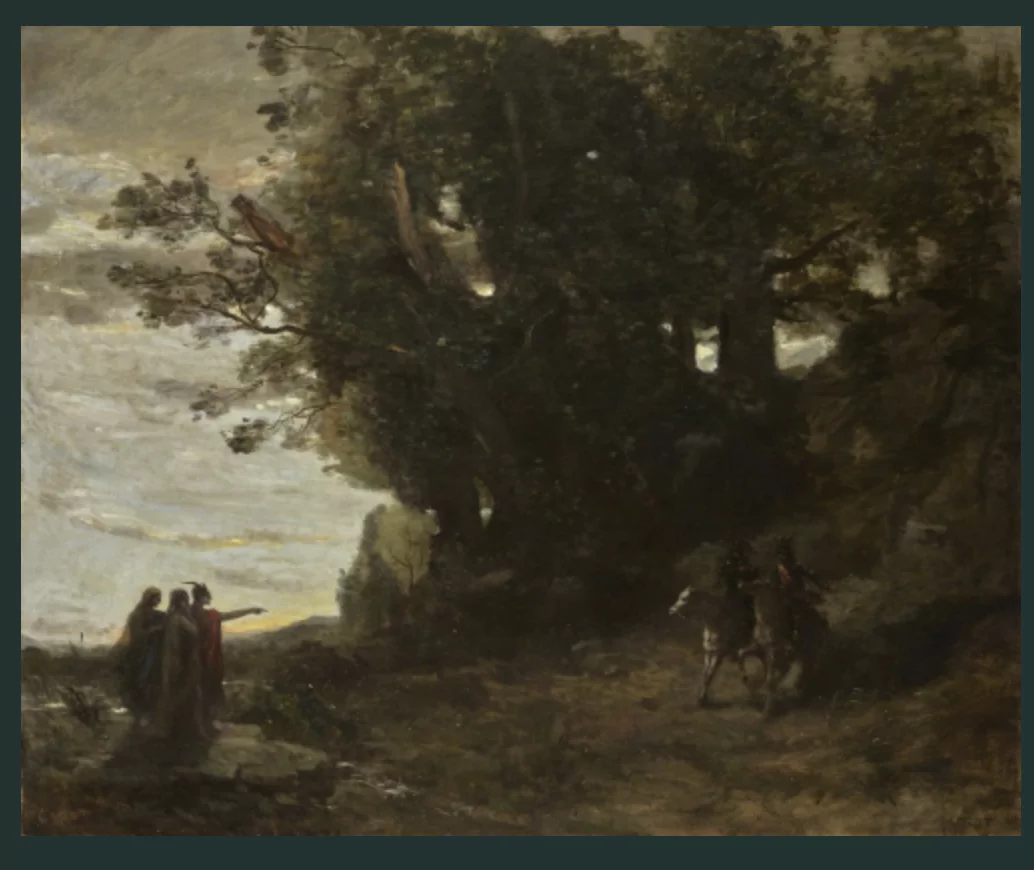
Corot, Italian Landscape (ca. 1835) oil on canvas, The Getty.
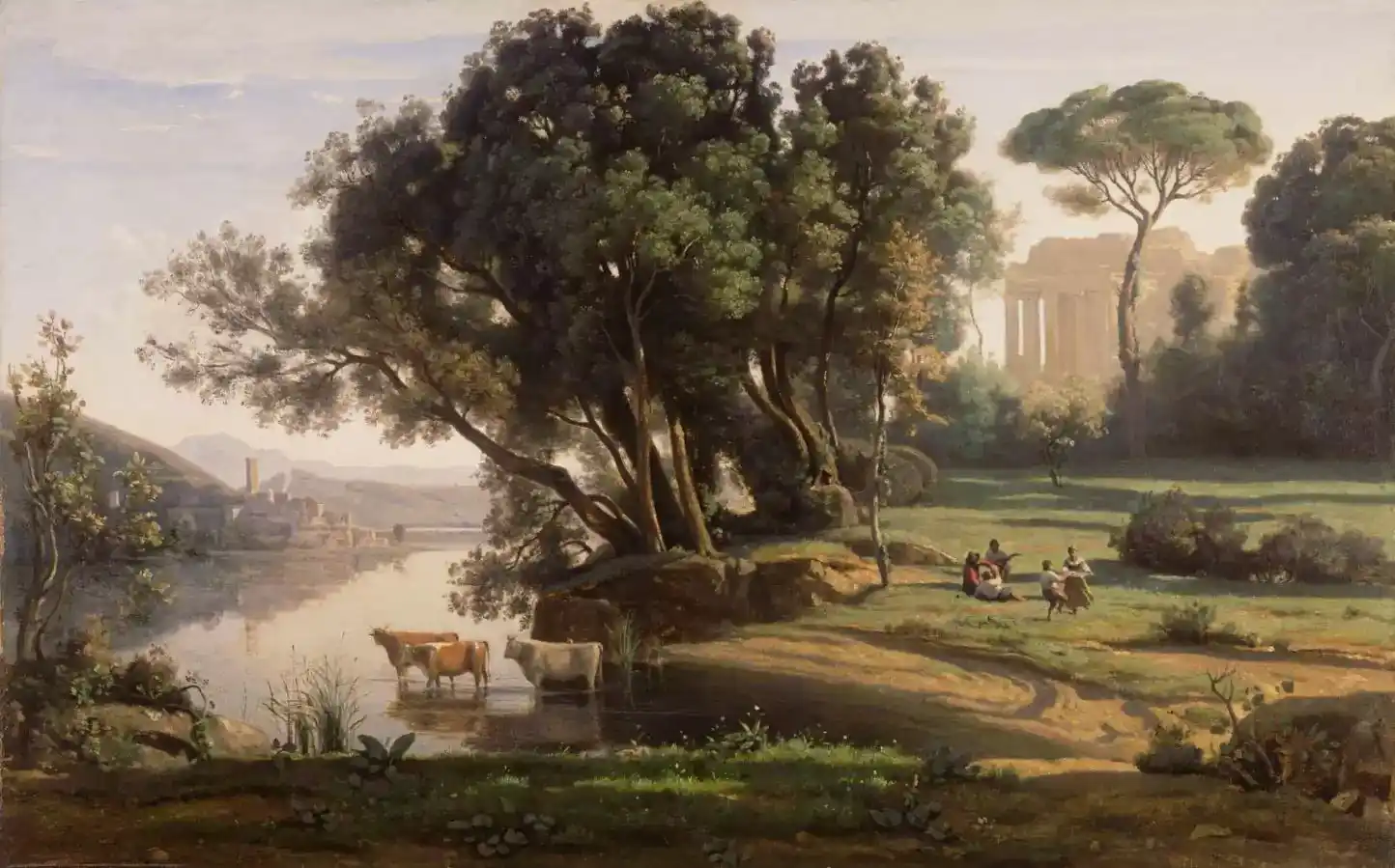
Corot, Macbeth, paysage (ca. 1858-1859) The Wallace Collection.
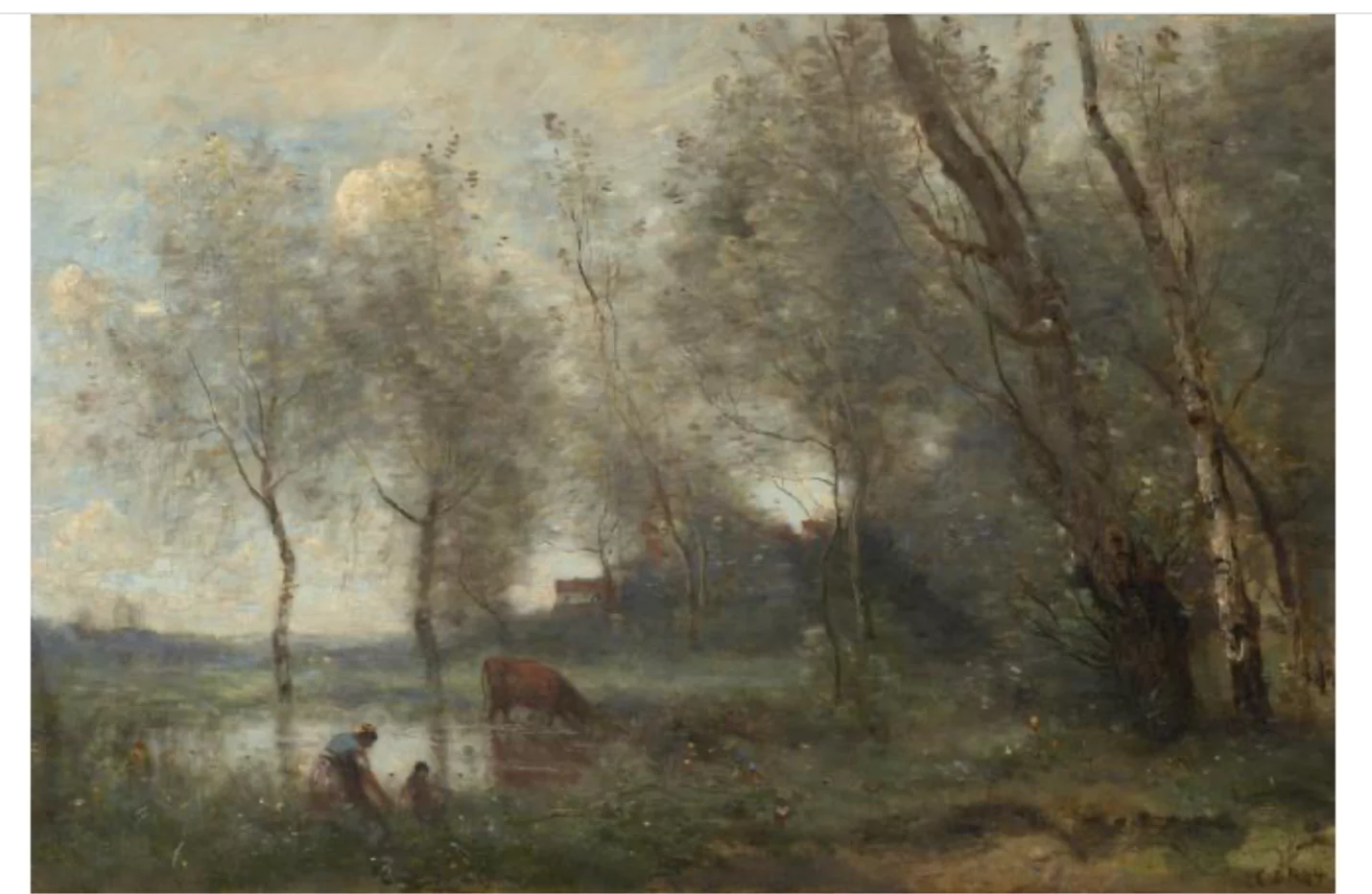
Corot, Ville-d’Avray (ca. 1860) oil on canvas, The Frick Collection.
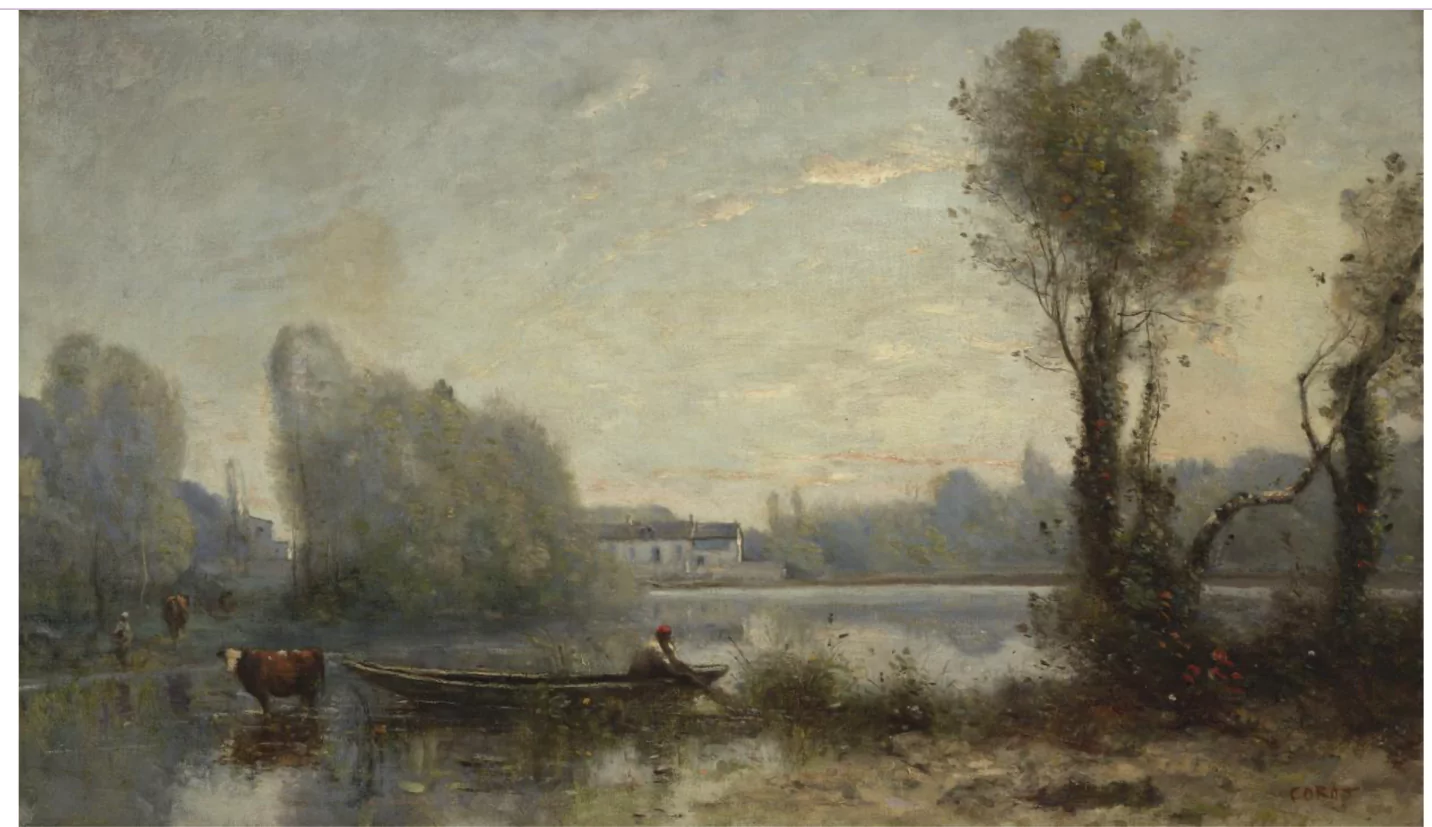
Corot, The Pond (ca. 1868-70) oil on canvas, The Frick Collection.
Camille Corot Childhood
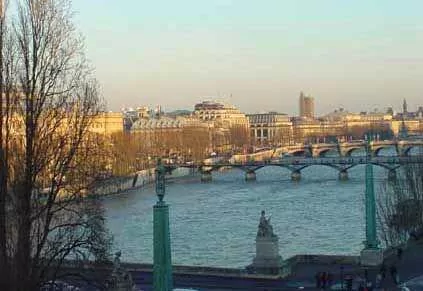
View Over the Seine Looking Toward Corot's Parisian Neighborhood
Jean Baptiste Camille Corot was born in Paris on July 16, 1796 into quite a successful middle class family. His mother, whom he always called “La Belle Dame,” was a stylish milliner of Swiss origin who came from a prosperous wine merchant family in Versailles. His father, who oversaw their store’s business finances, came from robust Burgundian stock from which Camille had the good fortune to inherit an exceptionally strong and healthy physique.
His family’s home in Paris was an apartment situated above their business, located on the fashionable corner of Rue du Bac and Quai Voltaire, at the end of the Pont Royal bridge.
Corot could see the Tuileries gardens and The Louvre from the windows of his home. We must presume that growing up in such a beautiful setting, where he lived for more than thirty years, had a substantial influence on Corot’s art.
Camille was enrolled in a small elementary school in the Rue Vaugirard in Paris where he stayed until 1806. At the age of eleven, his parents then sent him to the College de Rouen. A friend of the family, M. Sennegon, living in Rouen, was charged to look after the boy. The Sennegon family loved the out-of-doors, and shared their many nature walks through the woods and across the streams with Camille.
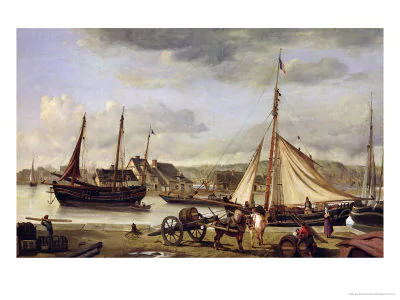
The Merchant's Quay at Rouen 1834
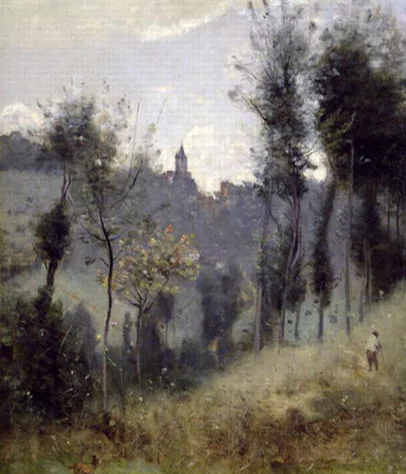
Canteleu Near Rouen, 1855
He spent five years there, relishing the countryside far more than the classroom. There, in Rouen, through the Sennegon family, Corot discovered a pantheistic love of nature that would become the foundation of all his artwork throughout his life.
He completed his formal education at a boarding school in Poissy near Paris at the age of nineteen. Although he finished his classical studies, it became evident that he was neither a brilliant student nor a businessman like his father. In 1815, Corot began a series of apprenticeships with cloth merchants. However he seemed more interested in making sketches and drawings than making cloth deliveries. In 1817, Corot started to spend all of his evenings painting, attending the art school, Académie Suisse in Paris.
In the same year, his father purchased a country home at Ville-d’Avray, ten miles from Paris. Camille instantly became enchanted by the 18th Century home surrounded with picturesque woods and ponds.
His bonding once again with nature only served to reinforce his desire to paint. The country settings at Ville-d’Avray would provide Corot with an immense amount of his “en plein air” paintings until the very end, only turning into a studio painter very late in his life due to the constraints of old age. Moreau-Nelaton made a very keen observation when he said, “Providence created Ville-d’Avray for Corot, and Corot for Ville-d’Avray.”
In 1822, when Camille was twenty-six, his father, weary of hearing his son’s complaints about working for the fabric dealers, finally asked him what did he really want to accomplish in a future career. He said firmly, “I want to be a painter.” Due to the untimely death of his younger sister, Victoire-Anne, her family’s allowance could now be made available to finance his lifestyle. This modest funding supported Camille comfortably for the remainder of his life. Later in his career, when he finally began to receive highly paid commissions, he continued to live on this allowance, sharing most of his professional earnings with less fortunate artists and friends.
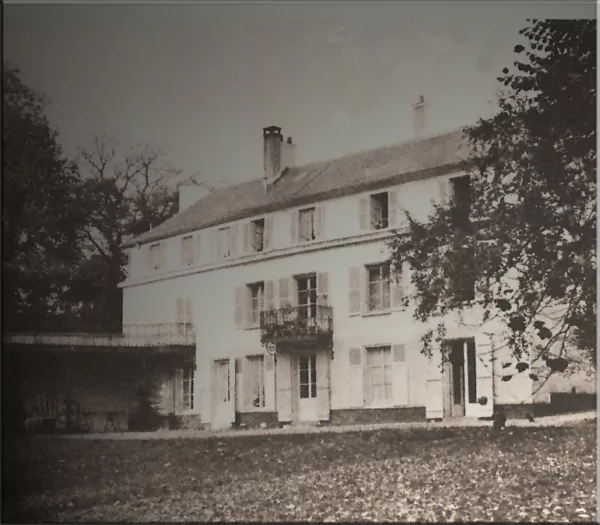
The Corot Family Home in Ville-d'Avray
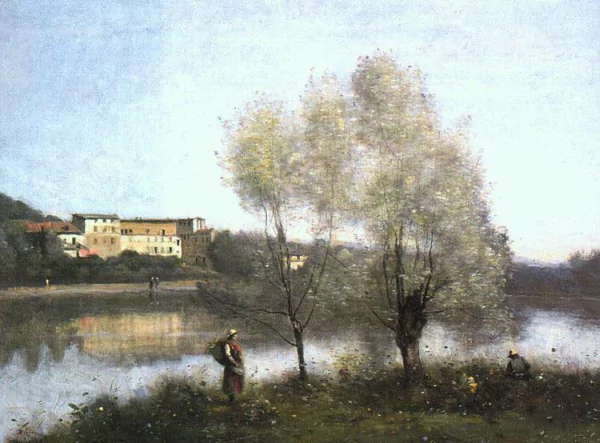
Ville-d'Avray, 1865
Life as a professional artist
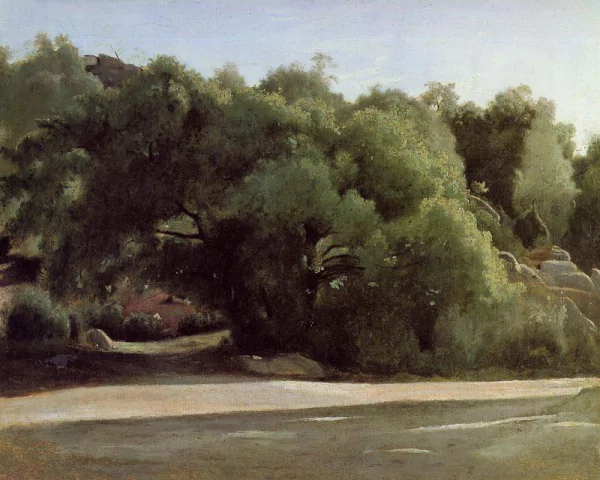
Fountainbleu the Chailly Road, 1822-1824
In 1823, Camille Corot graciously received his friends into his first artist studio, set up at 15 Quai Voltaire, near his family, within the beautiful setting of the Seine. Following in the footsteps of many French artists, he began to study the paintings in The Louvre. He received advice that he was never to forget from Achille-Etna Michallon, an established French landscape painter, “Look closely and be truthful in rendering nature.” After this mentor’s premature death in 1822, Corot moved on to the studio of Jean-Victor Bertin, a well recognized neoclassical landscape painter. It was during this time that Corot started combining the French neoclassical with the English and Dutch schools of realistic landscape art in his paintings.
In the early 19th Century, landscape imagery was perceived by the classical artists and art critics to be unworthy as the dominant subject matter in a painting.
At the time Corot embraced it, he was one of the few wielding a new path in the world of art.
The early forays into landscape art created new ideas and techniques regarding the ever essential form. Rendering nature as the ruling subject was in great opposition to the old classicist’s view that only the gods or the divined man of god could reign as king of the canvas. Nature, to them, was merely a surrounding backdrop for the human subject.
But to the landscape painter, especially to Corot, man lost this isolated importance within the context of his new cosmos, becoming merely one of the many organic parts of nature. It has been said that in a few of his works, he had other artists paint in the figures after he had completed his work, so disinterested was he in this part of his landscape creations.
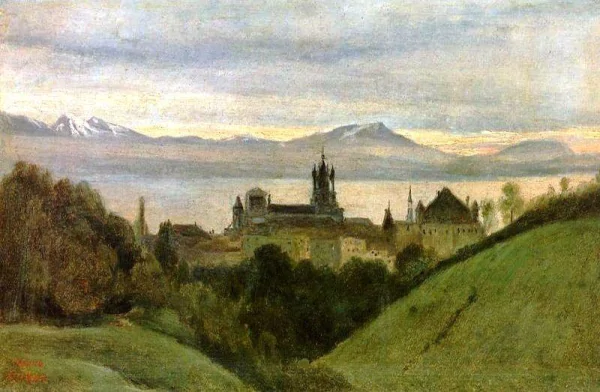
Lake Between Geneva and the Alps, 1825
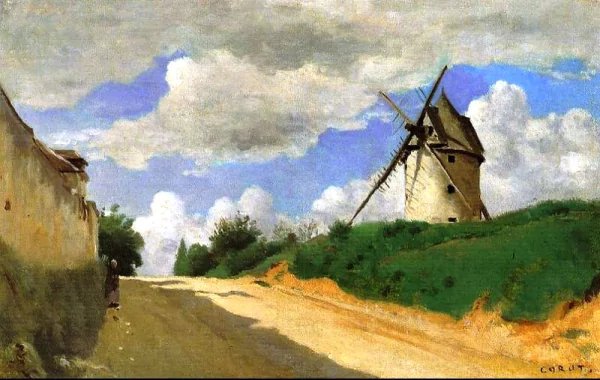
Windmill on the Cote de Picardie, near Versailles, 1835
First journey to Rome

Camille Corot Self-Portrait, 1825
A trip to Rome was a natural extension to Camille Corot’s Neoclassical studies under Bertin, so in 1825, his parents agreed to finance his trip with only one stipulation. They ask him to leave behind a portrait of himself for their home which he proudly agreed to do for them. This self-portrait is now exhibited in The Louvre. It serves us well as a measurement of his upwardly evolving painting style through time when compared to the self portrait done later in 1940. You can see the second one a little further on in this biography.
All of Corot’s journeys into Italy were made for the very definitive purpose to study the world before he set out to conquer it. The landscapes from this first Roman trip are still more, or less, in the nature of a reconnaissance as in a splendid topographical study. There is no doubt, that the one most essential skill he developed from his first Roman period was how to create the solid anatomy of the structure.
This would build the strong foundation to support all of his future “impressionist” painted imagery.
For three years, he traveled between Rome and Naples, perfecting his rendering of the subtlest values. He did visit the museums, although he never did set foot into the Sistine Chapel. He preferred the study of the “plein air” and his own visions to that of the great Italian masters. Tone was Corot’s great medium. “What there is to see in painting,” he said once, “or rather, what I look for, is the form, the whole, the equilibrium of tones. Color comes after this with me.” Like Rembrandt, he made color with light and shade.
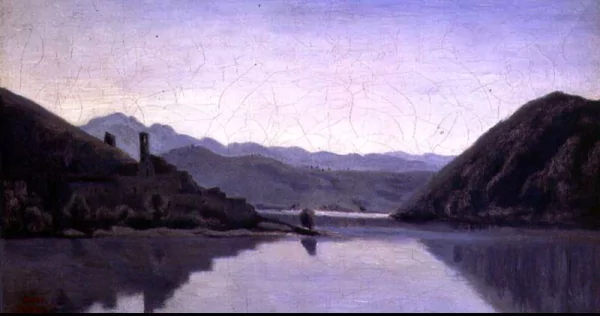
Lake Piediluco, 1826
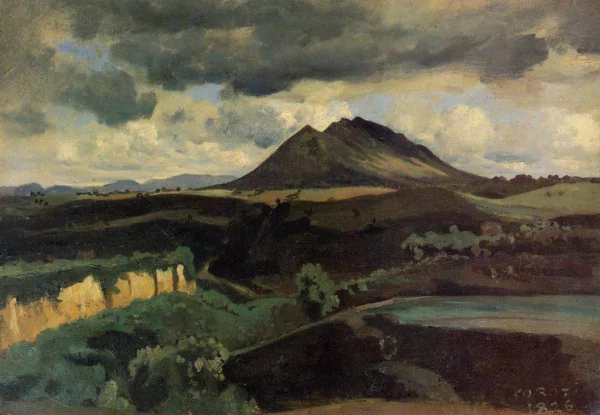
Le Mont Soracte, 1826
In 1826-27 the kinship between man and nature was beginning to be realized by Corot in Italy, painting out in the wide open countryside strewn with ancient ruins.
He finished hundreds of drawings and paintings, sending his first Salon entry, The Bridge at Narni, which showcased Corot’s open-air technique. Most importantly, it embodies “the retaining of the first impression view” that was to become the most essential signature of his work. It wasn’t just the Italian light and architecture, however, that Corot painted during his first visit to Rome. He fell in love with the Italian female form, painting the beautiful Roman women, but alas, always returning to his first love of landscapes.

The Bridge at Narni, 1826-1827
Return to France
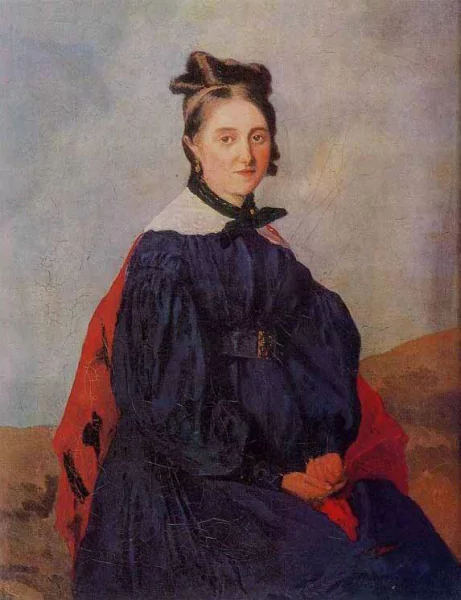
Mademoiselle Alexina Ledoux, 1830
In September, 1828, Camille Corot traveled back to France. While visiting his mother’s shop, he met the charming seamstress, Alexina Ledoux, whose portrait he painted two years later. Alexina was most probably the only serious love of his life, yet he seems to have given even her up for his all consuming dedication to painting. He would remain unmarried all his life, though he enjoyed a loving familial relationship with his sister’s family, filled with children and grandchildren at Ville-d’Avray, in which he shared ownership of the home with her, after their parents’ deaths. He went and came often over the years, traveling throughout Europe, most of all to Fontainebleau, Normandy and Brittany.
Then in 1830, he was driven out of Paris by the French July Revolution, taking refuge in Chartres where he executed two studies, from which he would later render the beautiful light-drenched Chartres Cathedral. Corot kept this painting in his studio most of his life and, in 1872, he gave it to Robaut. At that same time, he added the figure on the left and changed the one on the right. These corrections were confirmed by Robaut and are further authenticated by radiographs.
Corot became, thereafter, an avid traveler of the rural countryside, always surprising his friends by showing up in a different summertime locality as frequent as every two weeks. He would transition between en plein air, painting during the summer months, making small oil sketches of nature, and then utilizing his studio during the winter time for larger paintings that he would present at the Salon.

Chartres Cathedral, 1830
Second trip to Italy
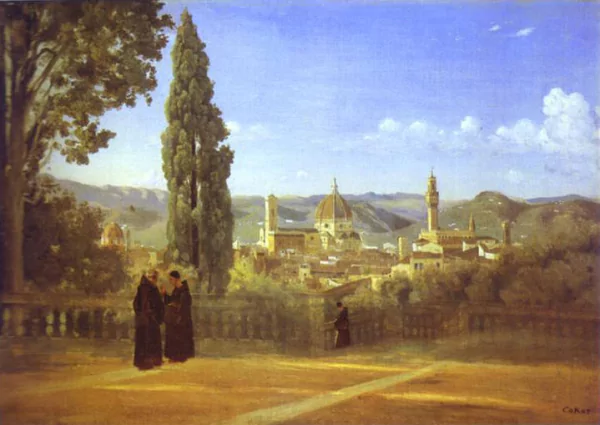
View of Florence from the Boboli Gardens, 1834
Corot was awarded his first medal at the Salon in 1833. The second-class medal was given for his work Ford in the Forest of Fontainebleau. Its present whereabouts are unknown. Upon receiving this award, Corot decided to take a second journey to Italy. He traveled with the painter Grandjean and stayed from May to October 1834, producing two distinct works. View of the Grand Canal and Santa Maria della Salute and View of Florence from the Boboli Gardens showcased both his independence and his nonconformist point of view that almost foresees twentieth-century painting.
During this time in Italy, Corot also painted his second self-portrait, showing that his command of the human figure was now mastered. It is one of the prized possessions of the Uffizi in Florence.
A comparison of this portrait to the one done earlier in 1825 gives us a vivid picture of the great distance he had traveled to consciously possess his full artistic power.
Always traveling, Corot spent time in his home at Ville d’Avray as well as at distant locations like La Rochelle on the Atlantic coast or to visit his friends, at the Bovy chateau in Switzerland. In the summer of 1840 he traveled to the Morvan. Between 1835 and 1865, as a guest, Corot executed decorative wall murals at many of his friends’ homes such as at the Daubigny’s house in Auvers-sur-Oise, the Bovys’ chateau, the house of the magistrate, Louis Robert at Mantes, and in the kiosk in the garden at his family home in Ville-d’Avray.
The exquisite View of Mantes and the Recollection of Mortefontaine were both inspired, along with hundreds of other paintings, by the serene rural surroundings, throughout which Camille traveled to the end of his life. Recollection of Mortefontaine was an outstanding success when exhibited in the Salon of 1864. The French government purchased it to hang in the palace of Fontainebleau, and then later moved it to The Louvre collection in 1889.
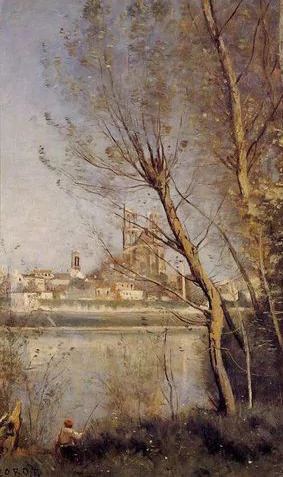
View of Mantes, 1868-1869
Last trip to northern Italy
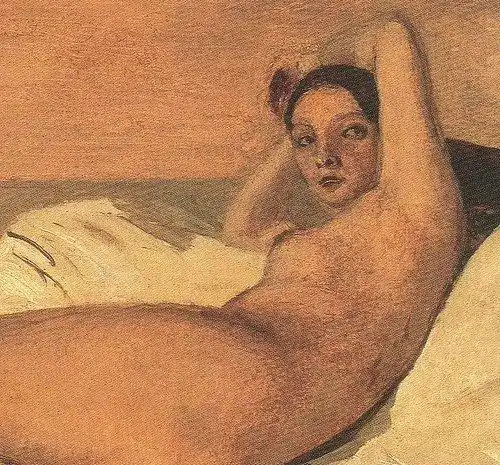
La Marietta, 1843
Corot’s third and last trip to Italy was made in 1843, a journey that produced La Marietta and Gardens of the Villa d’Este at Tivoli. This voyage lasted less than two years, where upon making his way back to Paris, he visited Normandy. This detour became the inspiration for his composition, Homer and the Shepherds, which critics acclaimed, leading to Camille Corot receiving the highest French award, the Cross of the Legion of Honor.
In 1851 shortly after Camille’s mother died, he went to live with his friend, Constant Dutilleux at Arras. The Dutilleuxes became his closest family, through whom he met Alfred Robaut, who would become like a son to him and eventually, his biographer. There is no doubt that the damp climate of northern France with its filtered and diffused misty light, transformed his paintings into lyrically poetic compositions. In this light, contours become blurred and values turned more subtle, leading to the silvery palette of his idolized Souvenir collection.
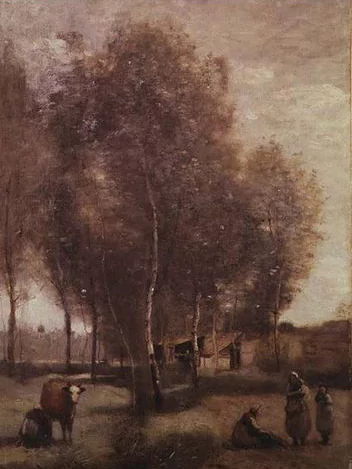
St. Catherine-les-Arras-Fields with trees and cottages, 1872
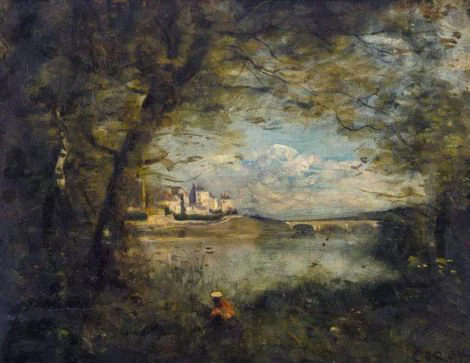
Souvenir du pont de Mantes, 1865-1869
His paintings would forever be transformed into an imagery of secretive pensive reverie.
Corot shifted between many styles and groups. Neoclassicism, Realism, and Romanticism, all had their place in his paintings.
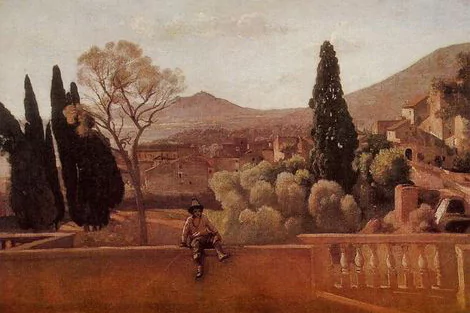
Gardens of the Villa d'Este at Tivoli, 1843
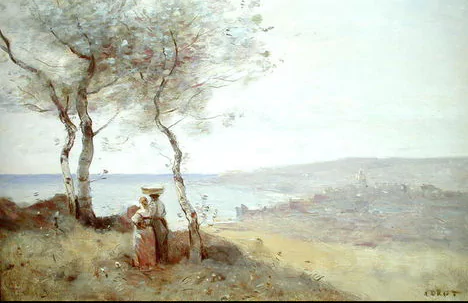
Souvenir of St. Jean de Luz, 1872

Souvenir of Italy, 1854
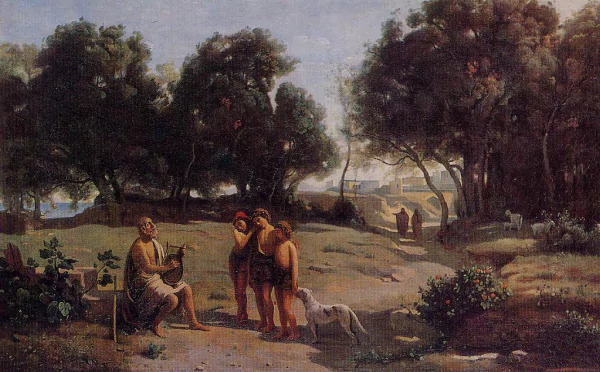
Homer and the Shepherds, 1846
Forerunner of Impressionist art
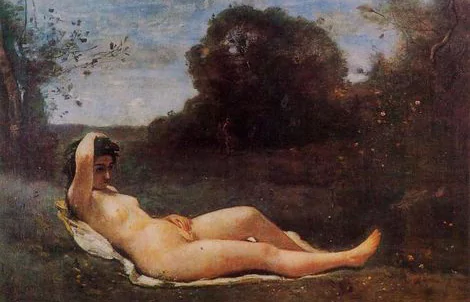
Reclining Nymph, 1855
Mastering the use of expressive light cleared a path for Impressionists to view Corot as an important teacher for their movement. He was certainly considered to be so, judging by a remark made by Monet, at age sixty, to an art connoisseur who had expressed great pleasure to be viewing so many Impressionist Masters’ works at one gathering.
Monet replied to him, “There is only one Master here….. Corot.”
Besides his well-known landscapes, Corot painted figures as well. His nudes are often overlooked, but they are of the highest quality. Carot’s nudes evoke a guileless essence bathed in their vaporous fairy-like expressions.
He idealized love, yet in a very acceptably credible fashion, by making the atmosphere the symbol. Cloaked in this euphoric magic, his women, painted in the 1860′s, take on the most incandescent loveliness. Two of his finest artworks, placing nudes in harmonious landscapes, are the Reclining Nymph, painted in 1955, and A Nymph Playing with Cupid, painted and shown in the Salon in 1857. It was the final effect of the figure he first dreamed and rendered many years earlier.
In 1830, he began creating many portraits of family and friends, which were usually produced on small canvases. During the years 1843 and 1857, one of his main subjects was young children. In this period, Corot painted one of his most successful portraits of a young boy. Maurice Robert as a Child, showing Camille’s ability to execute the frailty and vulnerability of childhood. In 1850, Corot began to paint large-scale figures, creating one of his most celebrated half-length portraits, Mille de Foudras. In the latter years of his career, Corot actually painted most of his portraits in his studio on Rue Paradis, his last working studio in Paris.
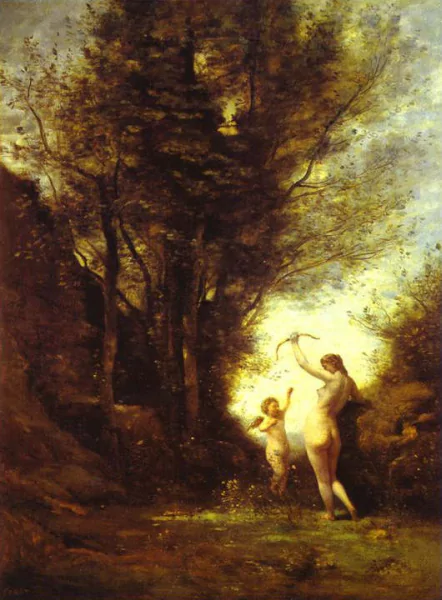
A Nymph Playing with Cupid, 1857

Maurice Robert as a Child, 1857
French Salon exhibits
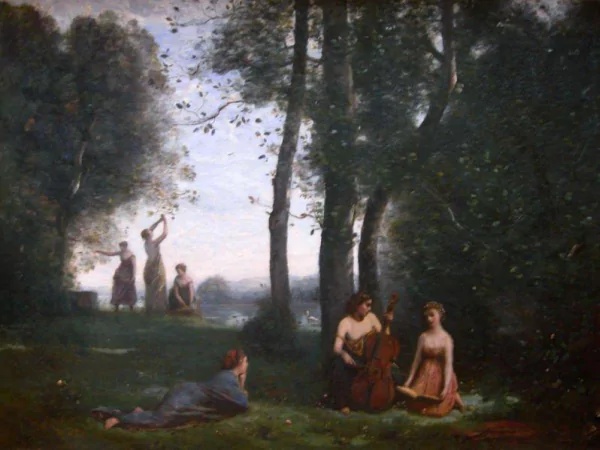
Concert Champetre, 1857-1858
To the Salon of 1857, Camille Corot sent seven pictures, among them five masterpieces. At last, Corot, the sexagenarian, received his long overdue fame. Not only was he finally acclaimed by the art critics, the people of France fell into a love affair with Camille Corot. Among them was Concert Champetre, which was owned by Dupre, and was purchased after his death by the Duc d’Aumale for Chantilly. It was an early picture that he had already exhibited at the Salon in 1844, but pared and refined, it captivated the very same people who had then ignored it. Two other jewels that stole their hearts were the Destruction of Sodom, and the Ronde de Nymphes and a Shepherdess, magnificently rendering the edge of a wood at sunset.
DRAWINGS/ETCHINGS/ENGRAVINGS
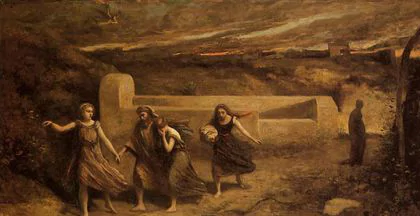
Destruction of Sodom, 1843
Corot also produced drawings and made etchings. Drawing was an integral part of this artist’s work. He produced nearly one thousand drawings and sketches, giving himself more freedom than what he showcased on canvas. In his early years, Corot used black pencil, red chalk, gouache, and pen and ink, all on various colors of paper. His technique began with precise and ridged botanical drawings produced during his first trip to Italy. This exactness is what would later lead him to become an excellent engraver.
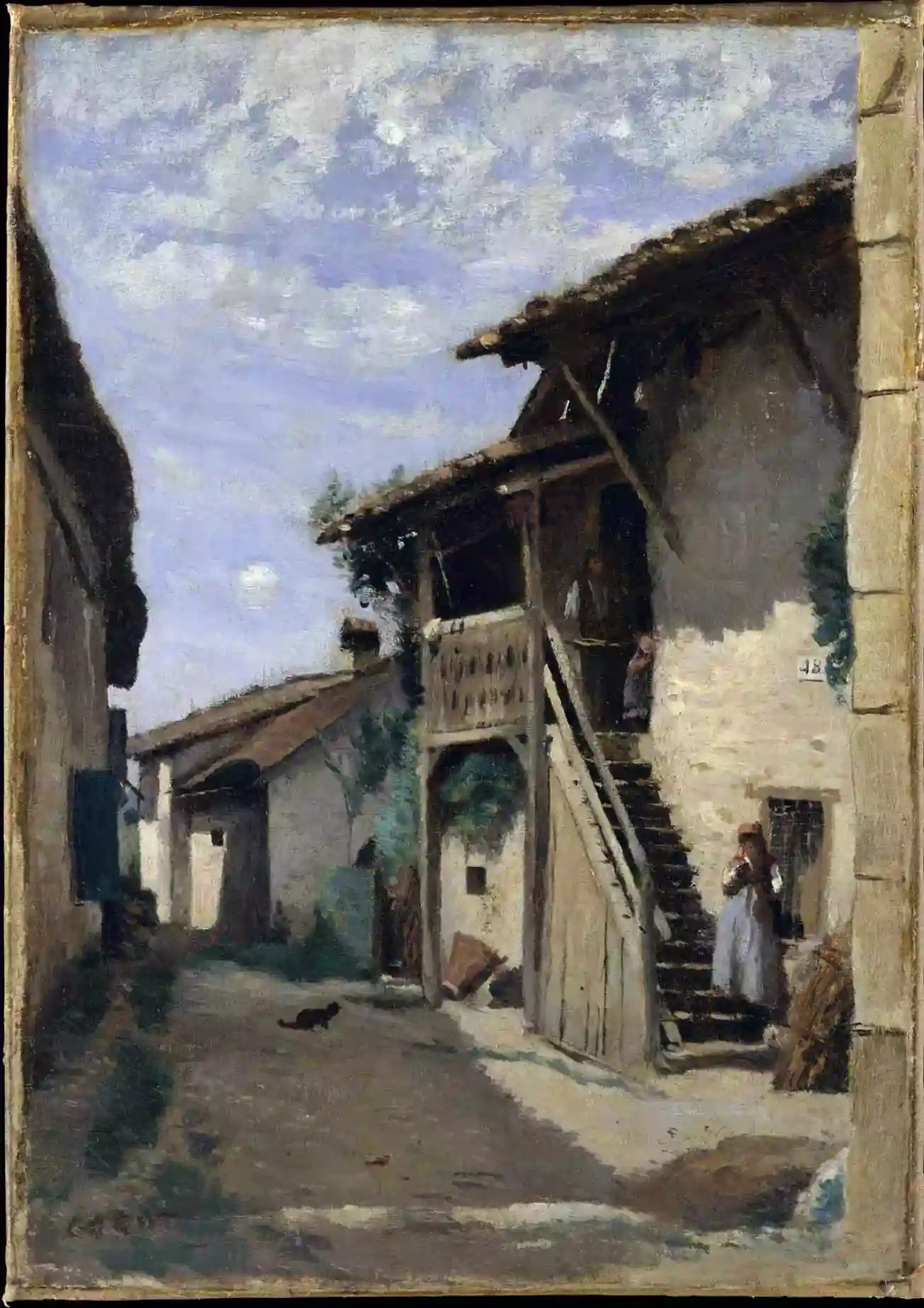
A Village Street: Dardagny, 1852-1857
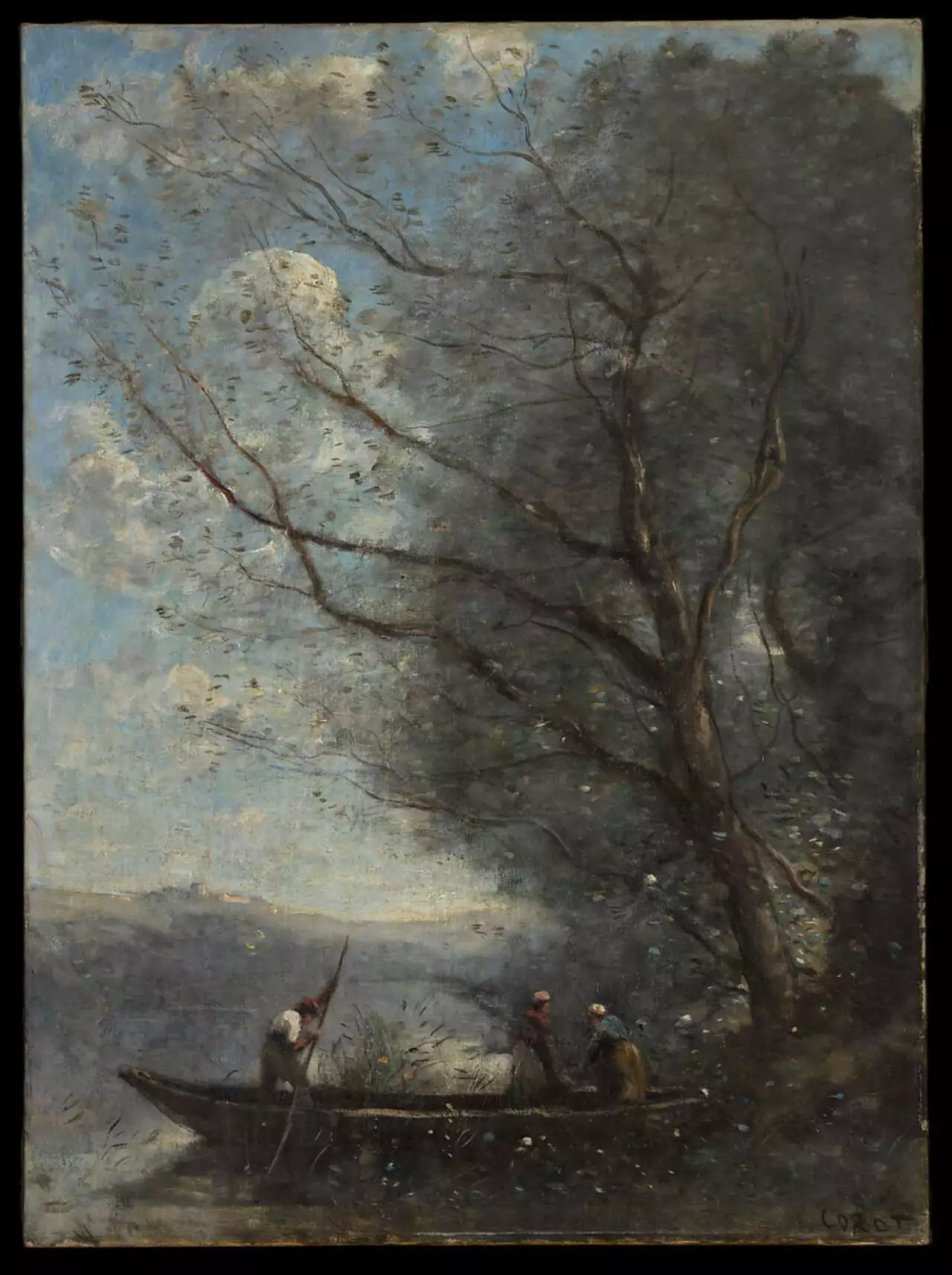
The Ferryman, 1865
A thriving artist till the end
In his later years, Corot began to soften his style. He paid ever more attention to the value of shading. His technique was more flexible, resulting with experiments in rendering light both in his paintings and his drawings. In 1853, he began making a series of visits to the English Channel, in which his use of charcoal emerged.
With his friend Constant Dutilleux, a lithographer, Corot began experimenting with a new process called cliché-verre. It was a new technique that combined photography and lithography. Corot produced sixty-six plates, however, he left the printing to others. Inspired by the Roman countryside, Corot’s most notable clichés-verre were The Gardens of Horace, Souvenir of Ostia, and The Banks of the Po River, completed between 1855 and 1858.
Cliche-verre was a new reproductive engraving technique discovered by his friend, Dutilleux, around 1853. This process combined photography and lithography. A plate of glass was first coated with printer’s ink with a lithographic roller, and then sprinkled with talc to quicken the drying time. The artist then drew on it with an engraver’s needle. A piece of sensitive paper was applied to the plate and then exposed to sunlight. This technique, unfortunately, only produced two or three proofs. Corot, always the fastidious craftsman, executed remarkable results. However, they never had the pristine beauty of the etchings and lithographs that he rendered toward the end of his life. There are but a handful of his etchings, but no one surpassed his mastery of this art, as a result of his endless quest for harmonious tonal values.